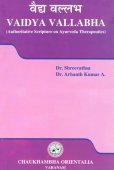Panduroga, Paṇḍuroga, Pāṇḍuroga, Pandu-roga, Pamduroga: 12 definitions
Introduction:
Panduroga means something in Hinduism, Sanskrit, Buddhism, Pali. If you want to know the exact meaning, history, etymology or English translation of this term then check out the descriptions on this page. Add your comment or reference to a book if you want to contribute to this summary article.
In Hinduism
Ayurveda (science of life)
Dietetics and Culinary Art (such as household cooking)
Source: Shodhganga: Dietetics and culinary art in ancient and medieval IndiaPāṇḍuroga (पाण्डुरोग) or simply Pāṇḍu refers to “jaundice” according to the 17th century Bhojanakutūhala (dravyaguṇāguṇa-kathana), and is commonly found in literature dealing with the topics of dietetics and culinary art, also known as Pākaśāstra or Pākakalā.—Accordingly, the dietetic effect pāṇḍuroga-ghna (cures jaundice) is associated with the following conditions: Food utensils made of Pāṭalapatra (patra=leaves). The dietetic effect pāṇḍuroga-hara (treatment of jaundice) is associated with the following conditions: Food utensils made of Āyasa (iron) and Kāca (glass).
Kalpa (Formulas, Drug prescriptions and other Medicinal preparations)
Source: Shodhganga: Edition translation and critical study of yogasarasamgrahaPāṇḍuroga (पाण्डुरोग) refers to “anemia” and is one of the various diseases mentioned in the 15th-century Yogasārasaṅgraha (Yogasara-saṅgraha) by Vāsudeva: an unpublished Keralite work representing an Ayurvedic compendium of medicinal recipes. The Yogasārasaṃgraha [mentioning pāṇḍuroga] deals with entire recipes in the route of administration, and thus deals with the knowledge of pharmacy (bhaiṣajya-kalpanā) which is a branch of pharmacology (dravyaguṇa).
Unclassified Ayurveda definitions
Source: archive.org: Science And Technology In Medievel India (Ayurveda)Pāṇḍuroga (पाण्डुरोग) refers to “anaemia” and is one of the various diseases dealt with in the Dhanvantarīyapathyāpathya, as is mentioned in A. Rahman’s Science and Technology in Medievel India: A bibliography of source materials in Sanskrit, Arabic and Persian.—Ancient and medieval India produced a wide range of scientific manuscripts and major contributions lie in the field of medicine, astronomy and mathematics, besides covering encyclopedic glossaries and technical dictionaries.—The Dhanvantarīyapathyāpathya deals with the treatment of various diseases [e.g., Pāṇḍuroga]. The word pathyāpathya classifies those elements as either beneficial or hurtful in disease.

Āyurveda (आयुर्वेद, ayurveda) is a branch of Indian science dealing with medicine, herbalism, taxology, anatomy, surgery, alchemy and related topics. Traditional practice of Āyurveda in ancient India dates back to at least the first millenium BC. Literature is commonly written in Sanskrit using various poetic metres.
Languages of India and abroad
Pali-English dictionary
Source: BuddhaSasana: Concise Pali-English Dictionarypaṇḍuroga : (m.) jaundice.
Source: Sutta: The Pali Text Society's Pali-English DictionaryPaṇḍuroga refers to: jaundice Vin. I, 206 (°ābādha) 276 (id.); J. I, 431; II, 102; DhA. I, 25.
Note: paṇḍuroga is a Pali compound consisting of the words paṇḍu and roga.

Pali is the language of the Tipiṭaka, which is the sacred canon of Theravāda Buddhism and contains much of the Buddha’s speech. Closeley related to Sanskrit, both languages are used interchangeably between religions.
Sanskrit dictionary
Source: DDSA: The practical Sanskrit-English dictionaryPāṇḍuroga (पाण्डुरोग).—jaundice.
Derivable forms: pāṇḍurogaḥ (पाण्डुरोगः).
Pāṇḍuroga is a Sanskrit compound consisting of the terms pāṇḍu and roga (रोग).
Source: Cologne Digital Sanskrit Dictionaries: Benfey Sanskrit-English DictionaryPāṇḍuroga (पाण्डुरोग).—m. the jaundice, [Suśruta] 1, 90, 11.
Pāṇḍuroga is a Sanskrit compound consisting of the terms pāṇḍu and roga (रोग).
Source: Cologne Digital Sanskrit Dictionaries: Cappeller Sanskrit-English DictionaryPāṇḍuroga (पाण्डुरोग).—[masculine] the yellow disease, jaundice.
Source: Cologne Digital Sanskrit Dictionaries: Monier-Williams Sanskrit-English DictionaryPāṇḍuroga (पाण्डुरोग):—[=pāṇḍu-roga] [from pāṇḍu] m. ‘yellow disease’, jaundice, [Varāha-mihira; Suśruta]
[Sanskrit to German]
Sanskrit, also spelled संस्कृतम् (saṃskṛtam), is an ancient language of India commonly seen as the grandmother of the Indo-European language family (even English!). Closely allied with Prakrit and Pali, Sanskrit is more exhaustive in both grammar and terms and has the most extensive collection of literature in the world, greatly surpassing its sister-languages Greek and Latin.
Kannada-English dictionary
Source: Alar: Kannada-English corpusPāṃḍurōga (ಪಾಂಡುರೋಗ):—[noun] = ಪಾಂಡು [pamdu]2 - 3.
Kannada is a Dravidian language (as opposed to the Indo-European language family) mainly spoken in the southwestern region of India.
See also (Relevant definitions)
Partial matches: Roga, Roka, Pandu, Pantu.
Starts with: Pandurogacikitsa, Pandurogaghna, Panduroganashana.
Full-text: Pandurogin, Pandu, Panduroganashana, Pandurogaghna, Pandvamaya, Bandhuka, Dhatuka, Rajata, Tamra, Salasaradi, Tarkshya, Nilamani, Gomeda.
Relevant text
Search found 11 books and stories containing Panduroga, Pamduroga, Pāṃḍurōga, Pandu-roga, Pāṇḍu-roga, Paṇḍu-roga, Pāṇḍu-rōga, Paṇḍuroga, Pāṇḍuroga, Pāṇḍurōga; (plurals include: Pandurogas, Pamdurogas, Pāṃḍurōgas, rogas, rōgas, Paṇḍurogas, Pāṇḍurogas, Pāṇḍurōgas). You can also click to the full overview containing English textual excerpts. Below are direct links for the most relevant articles:
Bhesajjakkhandhaka (Chapter on Medicine) (by Hin-tak Sik)
Internal Medicine (g): Jaundice < [Chapter 5 - Diseases and Treatments in the Chapter on Medicine]
Contributions of this Study < [Chapter 6 - Conclusion]
Charaka Samhita (English translation) (by Shree Gulabkunverba Ayurvedic Society)
Chapter 16 - The therapeutics of Anemia (panduroga-cikitsa) < [Cikitsasthana (Cikitsa Sthana) — Section on Therapeutics]
Chapter 19 - The Eight Abdominal affections (udara-roga) < [Sutrasthana (Sutra Sthana) — General Principles]
Atharvaveda and Charaka Samhita (by Laxmi Maji)
Pāṇḍuroga (anemia) according to Caraka < [Chapter 4 - Diseases and Remedial measures (described in Caraka-saṃhitā)]
Treatment of Pāṇḍuroga (Hariman) < [Chapter 3 - Diseases and Remedial measures (described in Atharvaveda)]
Treatment of Apvā disease (Jalodara or Dropsy) < [Chapter 3 - Diseases and Remedial measures (described in Atharvaveda)]
Sushruta Samhita, Volume 6: Uttara-tantra (by Kaviraj Kunja Lal Bhishagratna)
Chapter XLIV - Symptoms and Treatment of Jaundice (Pandu-roga) < [Canto III - Kaya-chikitsa-tantra (internal medicine)]
Chapter LI - Symptoms and Treatment of Asthma (Shvasa) < [Canto III - Kaya-chikitsa-tantra (internal medicine)]
Chapter XLV - Symptoms and Treatment of Hemorrhage (Rakta-pitta) < [Canto III - Kaya-chikitsa-tantra (internal medicine)]
Jivanandana of Anandaraya Makhin (Study) (by G. D. Jayalakshmi)
Pāṇḍuroga < [Chapter 4 - Āyurvedic principles in Jīvanandana Nāṭaka]
Matangalila and Hastyayurveda (study) (by Chandrima Das)
Summary of the Hastyāyurveda < [Chapter 1]
Related products

